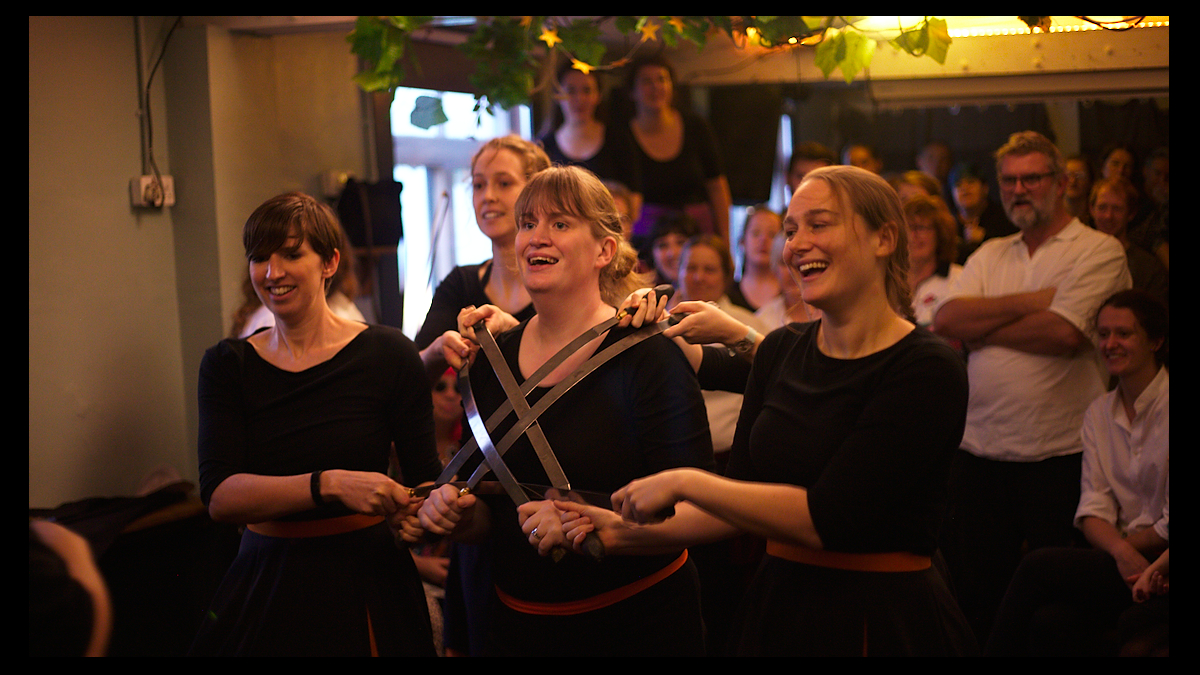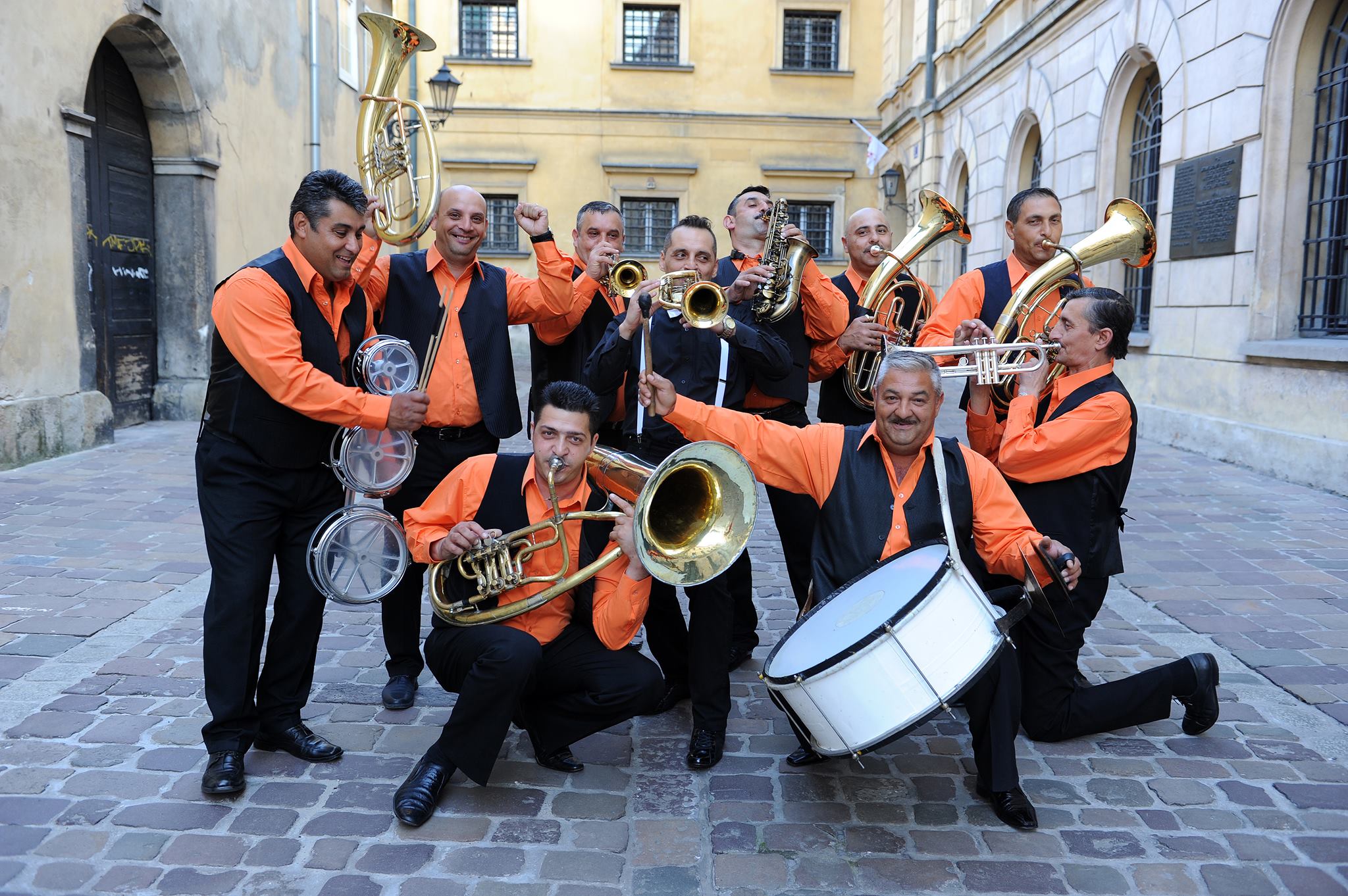|
Jeni Jol
{{no inline sources, date=November 2019 Jeni Jol is a Rom folk dance from the region of Skopje, Macedonia. It is a woman's line dance A line dance is a choreographed dance in which a group of people dance along to a repeating sequence of dance step, steps while arranged in one or more lines or rows. These lines usually face all in the same direction, or less commonly face each ot ..., in 2/4 meter, with a walking rhythm, with sensuous hip tilts. The dancers form a curved line, holding hands, and the dance moves to the dancer's right. The step pattern is 6 measures long. The dance is in the čoček musical genre that developed in the Balkans from Ottoman military bands in the 19th century, and is done to slow Rom brass band music, particularly the song ''Rumelaj''. The name of the group means "new road". See also * Music of the Republic of Macedonia Further reading *Dimovski, Mihailo. (1977:42-3). ''Macedonian folk dances (Original in Macedonian: Македонски наро ... [...More Info...] [...Related Items...] OR: [Wikipedia] [Google] [Baidu] |
Rom (people)
{{Infobox ethnic group , group = Romani people , image = , image_caption = , flag = Roma flag.svg , flag_caption = Romani flag created in 1933 and accepted at the 1971 World Romani Congress , pop = 2–12 million , region2 = United States , pop2 = 1 million estimated with Romani ancestry{{efn, 5,400 per 2000 census. , ref2 = {{cite news , first=Kayla , last=Webley , url=http://content.time.com/time/nation/article/0,8599,2025316,00.html , title=Hounded in Europe, Roma in the U.S. Keep a Low Profile , agency=Time , date=13 October 2010 , access-date=3 October 2015 , quote=Today, estimates put the number of Roma in the U.S. at about one million. , region3 = Brazil , pop3 = 800,000 (0.4%) , ref3 = , region4 = Spain , pop4 = 750,000–1.5 million (1.5–3.7%) , ref4 = {{cite web , url=http://www.mscbs.gob.es/s ... [...More Info...] [...Related Items...] OR: [Wikipedia] [Google] [Baidu] |
Folk Dance
A folk dance is a dance that reflects the life of the people of a certain country or region. Not all ethnic dances are folk dances. For example, Ritual, ritual dances or dances of ritual origin are not considered to be folk dances. Ritual dances are usually called "religious dances" because of their purpose. The terms "ethnic" and "traditional" are used when it is required to emphasize the cultural roots of the dance. In this sense, nearly all folk dances are ethnic ones. If some dances, such as polka, cross ethnic boundaries and even cross the boundary between "folk" and "ballroom dance", ethnic differences are often considerable enough to mention. Background Folk dances share some or all of the following attributes: *Dances are usually held at folk dance gatherings or social functions by people with little or no professional training, often to traditional music. *Dances not generally designed for public performance or the stage, though they may later be arranged and set for ... [...More Info...] [...Related Items...] OR: [Wikipedia] [Google] [Baidu] |
Skopje
Skopje ( , ; ; , sq-definite, Shkupi) is the capital and largest city of North Macedonia. It lies in the northern part of the country, in the Skopje Basin, Skopje Valley along the Vardar River, and is the political, economic, and cultural center of the country. As of the 2021 North Macedonia census, 2021 census, the city had a population of 526,502. Skopje covers 571.46 km² and includes both urban and rural areas, bordered by several Municipalities of North Macedonia, municipalities and close to the borders of Kosovo and Serbia. The area of Skopje has been continuously inhabited since at least the Chalcolithic period. The city — known as ''Scupi'' at the time — was founded in the late 1st century during the rule of Domitian, and abandoned in 518 after an earthquake destroyed the city. It was rebuilt under Justinian I. It became a significant settlement under the First Bulgarian Empire, the Serbian Empire (when it served briefly as a capital), and later under the Otto ... [...More Info...] [...Related Items...] OR: [Wikipedia] [Google] [Baidu] |
Line Dance
A line dance is a choreographed dance in which a group of people dance along to a repeating sequence of dance step, steps while arranged in one or more lines or rows. These lines usually face all in the same direction, or less commonly face each other.Knight, Gladys L. (2014). ''Pop Culture Places: An Encyclopedia of Places in American Popular Culture'', p.102. ABC-CLIO. .Lane, Christy (2000/1995). ''Christy Lane's Complete Book of Line Dancing'', p.2-4. Human Kinetics. .Zakrajsek, Dorothy; Carnes, Lois; and Pettigrew, Frank E. (2003). ''Quality Lesson Plans for Secondary Physical Education, Volume 1'', p.188. Human Kinetics. . Unlike circle dance, circle dancing, line dancers are not in physical contact with each other. Each dance is usually associated with, and named for, a specific song, such as the Macarena or the Electric Slide (associated with the 1982 single "Electric Boogie") which are a few of the line dances that have consistently remained part of modern American culture fo ... [...More Info...] [...Related Items...] OR: [Wikipedia] [Google] [Baidu] |
Bar (music)
In musical notation, a bar (or measure) is a segment of music bounded by vertical lines, known as bar lines (or barlines), usually indicating one or more recurring beats. The length of the bar, measured by the number of note values it contains, is normally indicated by the time signature. Types of bar lines Regular bar lines consist of a thin vertical line extending from the top line to the bottom line of the staff, sometimes also extending between staves in the case of a grand staff or a family of instruments in an orchestral score. A ''double bar line'' (or ''double bar'') consists of two single bar lines drawn close together, separating two sections within a piece, or a bar line followed by a thicker bar line, indicating the end of a piece or movement. Note that ''double bar'' refers not to a type of ''bar'' (i.e., measure), but to a type of ''bar line''. Typically, a double bar is used when followed by a new key signature, whether or not it marks the beginning of a ne ... [...More Info...] [...Related Items...] OR: [Wikipedia] [Google] [Baidu] |
čoček
Čoček (; Serbian and , ''čoček''; ; Romanian: sistemul) is a musical genre and dance that emerged in the Balkans during the early 19th century. It features prominently in the repertoire of many Romani brass bands. Čoček originated from Ottoman military bands, which at that time were scattered across the region, mostly throughout Serbia, Bulgaria, North Macedonia and Romania. That led to the eventual segmentation and wide range of ethnic sub-styles in čoček. Čoček was handed down through the generations, preserved mostly by Roma minorities, and was largely practiced at village weddings and banquets. Čoček is especially popular among the Muslim Roma and Albanian populations of Kosovo, South Serbia and Macedonia. When Tanec first came to America in 1956, they performed čoček as a Muslim woman's dance, "Kjupurlika" from Titov Veles. The kyuchek, as a common musical form in the Balkans (primarily Bulgaria and North Macedonia), is typically a dance with a time signa ... [...More Info...] [...Related Items...] OR: [Wikipedia] [Google] [Baidu] |
Balkan Brass Band
Balkan brass, popularly known by the Serbian name ''Truba'' ( sr-Cyrl, Труба, "Trumpet"), is a distinctive style of music originating in the Balkan region as a fusion between military music and folk music. In recent years, it has become popular in a techno-synth fusion throughout Europe, and in pop music in the Anglo-American sphere and throughout the world. Songs like Worth It by Fifth Harmony and Talk Dirty by Jason Derulo have brought the style to a new audience. In traditional form, it is popular throughout the Balkans, especially in Serbia, North Macedonia, Bulgaria, Moldova, and Romania, although the turbo-folk variety attracts larger audiences. The energetic and fast beats encourage dance and are egalitarian, often resulting in participation by the entire audience; this unpretentious relationship with audiences, highly charged energy and loud and joyful performances by highly skilled musicians has contributed to its successes. Fans of bands inspired by Balkan ban ... [...More Info...] [...Related Items...] OR: [Wikipedia] [Google] [Baidu] |
Music Of The Republic Of Macedonia
The Macedonian music refers to all forms of music associated with ethnic Macedonians. It shares similarities with the music of neighbouring Balkan countries, yet it remains overall distinctive in its rhythm and sound. Folk music The ethnic Macedonian folk music ( Macedonian: Народна музика, '' Narodna muzika'') includes: *Traditional music (Macedonian: Изворна музика, translit.: Izvorna muzika literally meaning: ''roots music'') *Contemporary folk music (Macedonian language: современа народна музика) Traditional music The Macedonian traditional music, which can be rural or urban ( starogradska muzika), includes: lyric songs, epic songs, labour songs, ritual songs, humorous songs, circle dance ("oro"), the old urban style called Čalgija (not to be confused with chalga) etc. Popular traditional songs are: '' Kaleš bre Anǵo'', ''Slušam kaj šumat šumite'', ''Biljana platno beleše'', '' Dafino vino crveno'', '' Zemjo Makedon ... [...More Info...] [...Related Items...] OR: [Wikipedia] [Google] [Baidu] |





